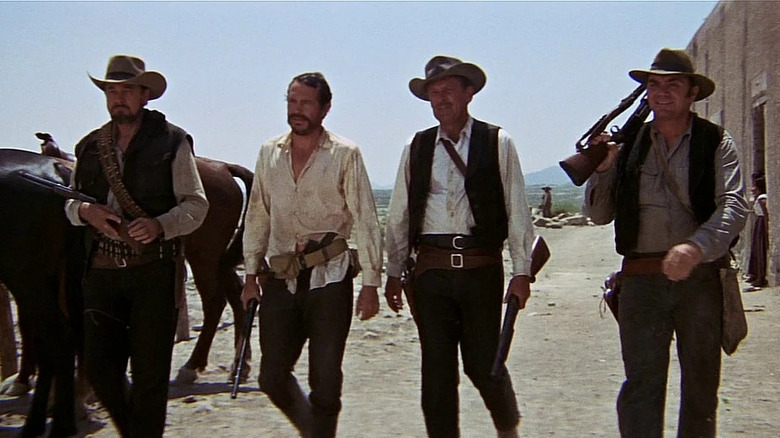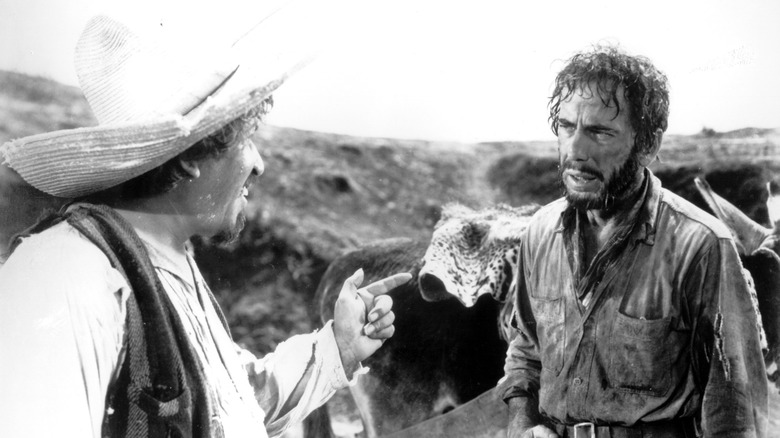The John Huston Western Classic That Inspired The Wild Bunch
Sam Peckinpah's elegiac revisionist Western "The Wild Bunch" inspired leagues of filmmakers from Quentin Tarantino to Kathryn Bigelow. Its story of a gang of aging outlaws battling an ever-changing, rapidly mechanizing Western landscape shifted the trajectory of the Western picture, ensuring its place among the greatest films of all time. Hollywood has been trying to launch a "Wild Bunch" remake for over a decade now, beginning with a proposed Tony Scott version (starring Will Smith, who would also produce) that stalled with his death in 2012, along with one directed by "Hands of Stone" filmmaker Jonathan Jakubowicz, and eventually, David Ayer was up to helm a remake based on his own script. None of these projects came to fruition, though last we heard, Mel Gibson was said to helm the latest reboot attempt. "The Wild Bunch" continues its hold on storytelling today, but who influenced the influencer?
The "Bring Me the Head of Alfredo Garcia" director didn't consider his 1969 film to be a Western movie at all, but a Mexican one. "Taxi Driver" screenwriter and "First Reformed" director Paul Schrader, during his days writing for Cinema Magazine, went long on "The Wild Bunch," Peckinpah's career trajectory up until that point, and what he was tapping into when he crafted his masterpiece. Peckinpah points out that "The Wild Bunch" is a grim meditation on Richard Brooks' 1966 men-on-a-mission horse opera "The Professionals," about a team of killers sent to Mexico on a rescue mission. "['The Wild Bunch'] is what really happens when killers go to Mexico," he says. But Brooks' setting of the Mexican border was too gentle for Peckinpah's tastes. "The Wild Bunch" was a tale of brutes in a brutal land, where the location must have an entire mood of its own. For that, the filmmaker turned the clock back to 1948, when John Huston adapted B. Traven's 1927 adventure novel and ran for the gold-filled hills. Peckinpah told Schrader:
"'Treasure of Sierra Madre' is one of my favorite films. In fact, 'The Wild Bunch' is sort of early Huston. Ever since I saw that film I've been chasing Huston."
"The Treasure of the Sierra Madre" is a tale of greed and gold-digging in 1920s southeast Mexico, Huston's third feature. Shot largely on location in Tampico, San Jose de Purua and in Durango (a feat in the Golden Age of cinema), the film's locale informs the story so intensely that it's easy to draw a creative line from Huston's "know the land" caveat to Peckinpah's land of savagery, where violence flows like wine and the only truly clean hands are dead ones.
Mad men
"The Treasure of the Sierra Madre" stars Humphrey Bogart, Walter Huston, and Tim Holt as a trio of men on a quest for gold in 1925 Mexico. Roger Ebert writes, "the movie has never really been about gold but about character," and these characters put themselves through the wringer for the money. Bogart is Fred C. Dobbs, a downtrodden drifter who's got farther to fall; in the descent, Bogart turns in a career-high performance. He links up with another American drifter, Bob Curtain (Tim Holt), and together the two meet the elder Howard, played by the director's father Walter Huston. Howard knows a thing or two about a thing or two, including how to find gold and stay alive long enough to cash in and enjoy its spoils. With Howard's expertise (he speaks the most Spanish and knows the area best), Dobbs and Curtain join him in "the mountain" to begin prospecting. Their quest is plagued by the elements, bandits, and the mens' exposure within the harsh landscape, but the greatest danger comes from the depths of their own greed and paranoia. Not everyone makes it out alive, and the mountain drives some of the men to extremes.
But where "Treasure" gives its haggard men a choice to kill, the Mexico of "The Wild Bunch" holds no place for a morally pure person to function at all. That infamous Battle of Bloody Porch lets the bullets fly for five minutes — long after the audience's appetite for bloodshed has been satiated. It's a statement, and so critical reaction to that excess depends on whether they find it sublime or needless, but that's the way Peckinpah plays it. There's a whole lot of killing going on in this movie: women trampled underfoot, throat slashings, men mowed down by machine gun. The ugliness requires a space that will enable, maybe even encourage it the way the dingy corners and rural upstate alike of New York would reflect a national psyche a year later with the arrival of John G. Avildsen's "Joe."
Passages of the mechanism can be found across genres; Dan Gilroy's 2014 thriller "Nightcrawler" observes its vulture-like stringer Lou Bloom as he navigates a professional world that has created a demand for the unethical. The Mexico of "The Wild Bunch" seizes the men's ferocity and achieves what "The Professionals" couldn't when it sent its pros south of the border; it makes the bloodshed so much more plausible. The potent Mexican landscape of "The Treasure of the Sierra Madre" leavened its story of men and money, but the unblinking, unforgiving scenery of "The Wild Bunch" soaks its men in savagery, and then comments on it.

